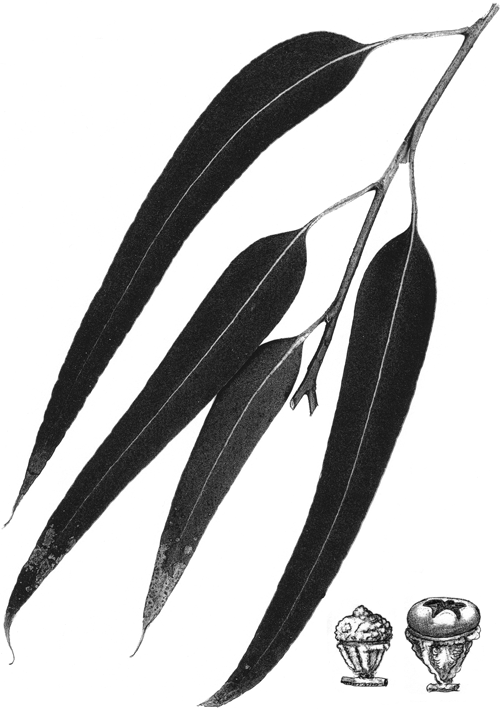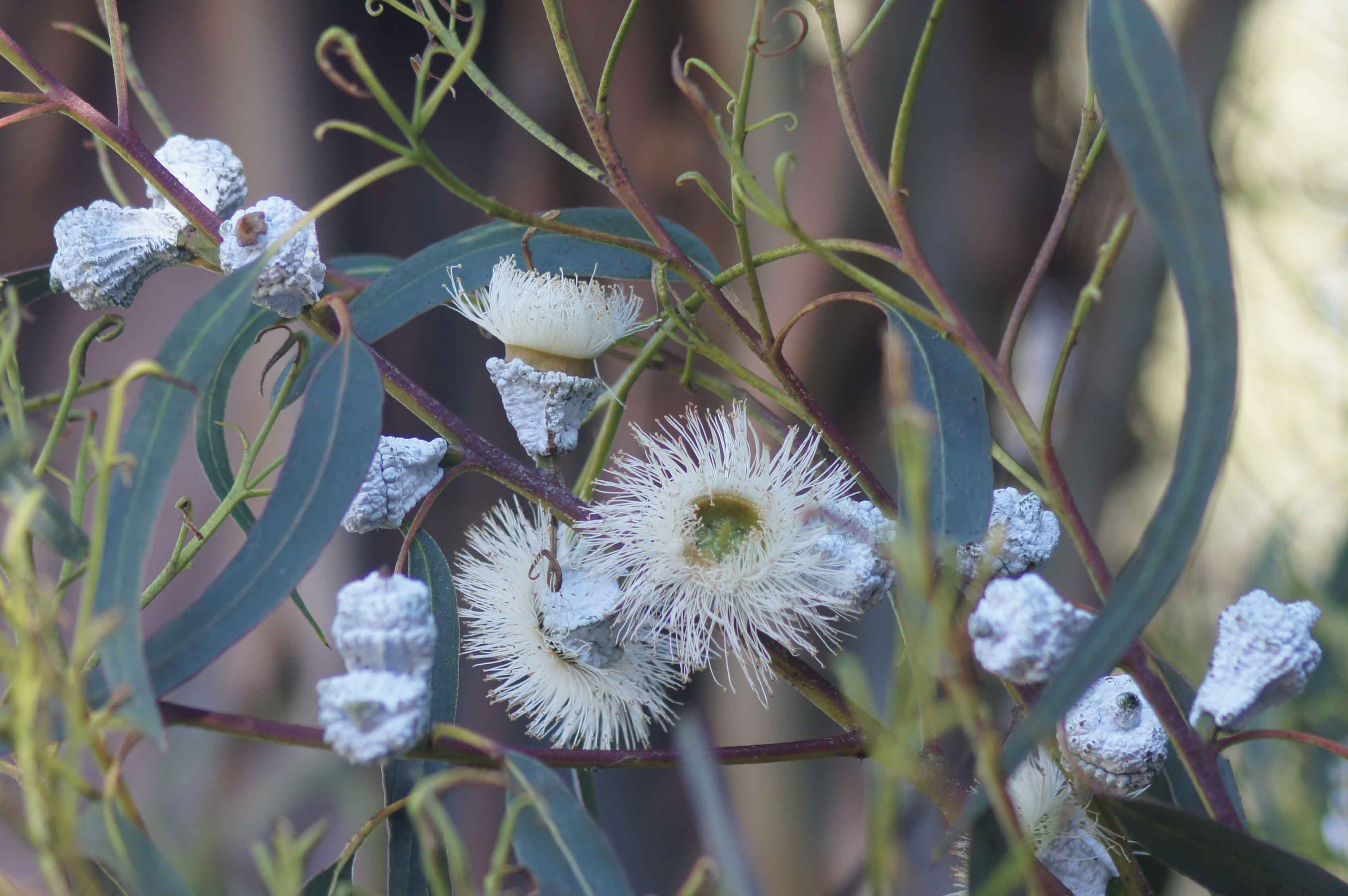Eucalyptus globulus
 Tasmanian blue gum
Tasmanian blue gum

Introduced to San Francisco in 1853 from Australia at a time when transpacific shipping was booming because of big gold discoveries, the Tasmanian blue gum soon attracted attention because of its rapid growth. By 1860 substantial 50-foot trees, originally planted as ornamentals, attested to the astonishing ability of this plant to create wood in a hurry. By the 1870s planting was under way for fuel, windbreaks, and shade. California Senator Ellwood Cooper published Forest Culture and Eucalyptus Trees (Cubery & Co., San Francisco, 1876), giving an enthusiastic report of his experimental plantings near Santa Barbara, with details of planting, harvesting, and costs and sales. Cooper visited Tasmania and saw the giant trees in their native habitat; his book reports two fallen specimens of E. amygdalina with measured heights of 460 and 512 feet respectively. (No living tree is known today that tops the tallest living Sequoia.) The fame of the virgin forests quickly spread around the world. A single plank 75 feet long and 10 feet wide was shipped to the London Exhibition of 1862 (and later returned). A 165-foot plank that was also to be sent could not find a shipper. In 2001 the tallest reported in the United Stares was 160 feet high and 38 feet in girth, growing in Petrolia, California.
Circular No. 2 issued by the California State Board of Forestry in 1907 showed photographs of 24-year-old blue gums over 3 feet in diameter and 175 feet tall and included extensive tables of the yield of dozens of plantations that by then existed.
After oil was discovered in Pennsylvania in 1859, it was only a few decades until wood fuel disappeared from use in California, except for domestic firewood. In 2003, blue gum and oak were both selling at around $200 per cord (128 cubic feet, or about 2 tons). Plantations for fuel were in many cases never harvested. The closely packed grove across from the football stadium, planted by the Stanford Trustees in 1916 as an investment, is one such. There are remnants of another on Alpine Road at Piers Lane, near the site of the isolation hospital that was built in 1912 and used during the worldwide influenza pandemic of 1918–1919. We forget that wood was California’s principal fuel – yet today half the world’s wood is still harvested for fuel.
Two thousand miles of blue gums have been planted in Southern California to protect citrus groves from cold winds. Many blue gum plantations in California have been returned to farm land, but survivors did prove to be salable on the stump, to Japan. The logs are loaded onto special factory ships and arrive in Japan, value-added, reduced to chips and ready for manufacture into chemicals and paper. The technology for making paper from eucalypts was developed in Australia during World War II when outside supplies were cut off. A similar wood-chip trade exists from Tasmania, where Japan has invested in a port and railway into the interior for getting the blue gums, three-quarters of which have now been removed. For economic reasons, old growth forest of other hardwoods is being logged, to be replaced by Monterey pine and other fast growing tree crops despite protest by the community. Balancing economics against environmental concern is precarious: the Green movement in Australia was effective in blocking the construction of a hydroelectric dam in the Tasmanian wilderness but the needed electricity is now generated by a coal-fired power station. In California commercial blue gum planting is now history, as ornamental planting has shifted attention to other eucalyptus species.
In Peru, the blue gum is the main source of poles, railroad ties, and timber for industrial use. Ecuador celebrated the genus with a postage stamp. By 1981 both Brazil and China had planted six million trees as a source of fuel, railway ties, fence posts, poles, tool handles, pulp, and oils.
Portugal and Spain are now the main world source of eucalyptus oil, made from blue gum leaves, and used in medicine, candy, cosmetics, antiseptics, disinfectants, deodorants, and solvents, and for the manufacture of menthol and other chemicals. The leftover blue-gum wood goes mainly into paper. Most of the oil extracted is cineole (eucalyptol); other components, sold separately, include phellandrene, and citronellal. All members of the myrtle family have oil glands containing various essential oils in their leaves, flowers, and other parts.
In Ethiopia, the capital city Addis Ababa used to be migratory, moving on when the time taken to forage for firewood and leaves for cooking did not leave enough time for cooking. The introduction of the blue gum not only stabilized Addis Ababa on its present site but generated a principal economic activity.
In Egypt, where blue gums are known as fever trees, it was forbidden to gather leaves from street trees for home medication. People took the leaves because they knew that the trees had been responsible for curing malaria (= bad air) in the Pontine marshes. In California, Senator Ellwood Cooper was responsible for cleaning up malaria-ridden Bakersfield; he had demonstrated to his own satisfaction that eucalyptus oil was germicidal by putting two jars containing meat out in the open, one containing blue gum leaves. At that time he did not know that malaria is carried by mosquitoes, not by bad air; but by drying up the swamps he was successful. In southeast Africa there is “the great grey-green, greasy Limpopo River, all set about with fever-trees” (Kipling). These may have been acacias. The name malaria was first applied to the disease when it was noticed that outbreaks of fever on Elba followed an offshore wind from the Maremma, a malarial area of Tuscany uninhabitable since Roman times. The correlation with wind was evidently explained by transport of mosquitoes rather than 'bad air.' On second thought, the air was not good.
At Stanford, the long arm of Governor’s Avenue ran a mile due north from Lake Lagunita without interruption to the old Gordon residence on San Francisquito Creek; it was planted in the late 1870s with blue gums that now have girths up to 23 feet (for example between Searsville Road and Panama Street). More than 700 trees were planted 20 feet apart. When I counted them in 1972 there were 427 on the long arm and 143 on the short arm that continues for one-third of a mile from Lake Lagunita to the Red Barn. The short arm does not run due west; it was laid out, like the central campus streets, with a transit equipped with a magnetic compass. Consequently, the angle between the two arms is 75 degrees, not a right angle. Dry years in the 1970s and 1980s and freezes in 1972 and 1978 weakened many trees that then succumbed. Many well-spaced specimens dating from the planting of the arboretum stand in the wedge north of Campus Drive East and Galvez Street, and on to El Camino Real. Trees with heights of 110 feet and girths of well over 20 feet can be seen. Eight members of Governor’s Avenue that shaded the Welch Road Medical Complex were removed in January 2003. They had an average stump diameter of 5.6 feet; the largest had a diameter of 7.9 feet, or a girth of 25 feet. That is about as big as campus trees come, redwoods included.
Juvenile leaves are broad, roundish, and have a thin coat of bluish wax that insulates seedlings against cold. These leaves occur in pairs on opposite sides of the stem. The next pair up the stem emerges at right angles to the previous pair. Examination makes it apparent that there are four strands inside the stem. Twirling the stem between the fingers confirms a square cross-section. Mature leaves are more green than blue, long and narrow in proportion, and can be over a foot long. I once put a stamp on one and it was delivered in Los Altos Hills. The mature leaves are said to be alternate, as distinct from opposite, but close inspection reveals that in fact they are still grouped in pairs, the members of one pair being separated by only a short length of stem. The next pair is generated from the other two of the four strands. They may not be at right angles to the preceding pair, however. If better exposure to sunlight is obtainable, the stem will be twisted 90 degrees so that the leaf stalks are arranged more or less in a plane. Juvenile foliage is found near the base of tall old trees if there has been some damage to the bark. If you take a stroll in the Arboretum, visiting these numerous blue juvenile outbursts, you will find one with hexagonal stems, six strands, and triplets of leaves instead of pairs. Each triplet up the stem is rotated 60 degrees.
The abundant flowers are creamy white and the large fruits, nearly an inch across, have a pale blue waxy coating, protruding ridges and warts, and an operculum to match. Very occasionally you may find a tree with red flowers. In Tasmania, the fruits come in ones, but here they often come in threes. This is thought to be due to hybridization with E. bicostata, a related three-flowered tree whose range extends across Victoria and well into New South Wales.
Campus squirrels eat the seeds. Instead of removing the cap to release them, as nature does, some squirrels know where to gnaw on the back of the fruit so as to enter each of the four (sometimes three or five) loculi where the seeds reside. Since squirrels did not evolve in the Eucalyptus forests, they must have learned from their parents. See fallen fruit subjected to this surgical operation.
Good indigenous blue gum seed, valued for wild-tree genetic variability, sold for $9000 per pound in 2001. (Compare with about $50 per ounce for the best caviar.) The price is likely to go up in response to demand for large-scale worldwide revegetation projects, creating a business opportunity for farmers in Australia.
Since 1927 a multistemmed relative has been sold in California under the name E. globulus ‘Compacta’, bushy blue gum, or dwarf blue gum. It is certainly bushy, with dozens of trunks and foliage reaching to the ground, but is certainly not compact or dwarf. The original mutant germinated around 1890; since then its seedlings have bred true. It is now about 80 feet high with a 50 foot spread. Bushy blue gum is used as a screen in highway planting, for example where El Camino Real borders the campus. It has migrated back to Australia where it is distributed by the state Forestry Commissions for use in windbreaks and as a home for koalas.
Name derivation: Eucalyptus – from the Greek eu, good or well, and kalyptos, covered, referring to the calyx which forms a lid over the flowers when in bud; globulus – globular, from the Latin for small, round ball, from California Plant Names.
Related material: Stanford Grounds Plant Information Sheet, List No. 6, Page 8.
About this Entry: The main text of this entry is from the book Trees of Stanford and Environs, by Ronald Bracewell, published 2005.





